The first step towards vehicles driving with limited human intervention was probably realized by GM in the late 1950s, but they required burying cables in the roads (a Ford engineer said that GM's idea would take a century to implement ... ) :
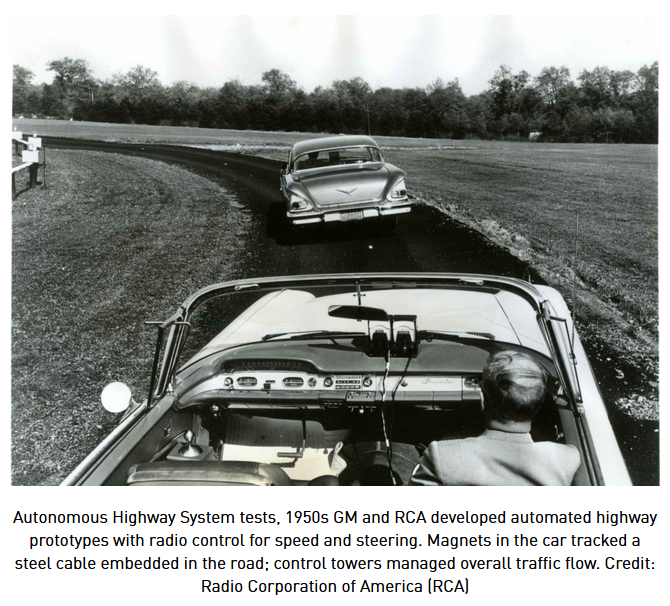
In 1958, the first cruise control was proposed on a production vehicle by Chrysler on the Imperial. The feature was called ... AutoPilot :) [1]

In 1968, people at Stanford were imagining Computer Controlled Cars. The author of this paper, John McCarthy, is seen today as one of the founders of artificial intelligence.
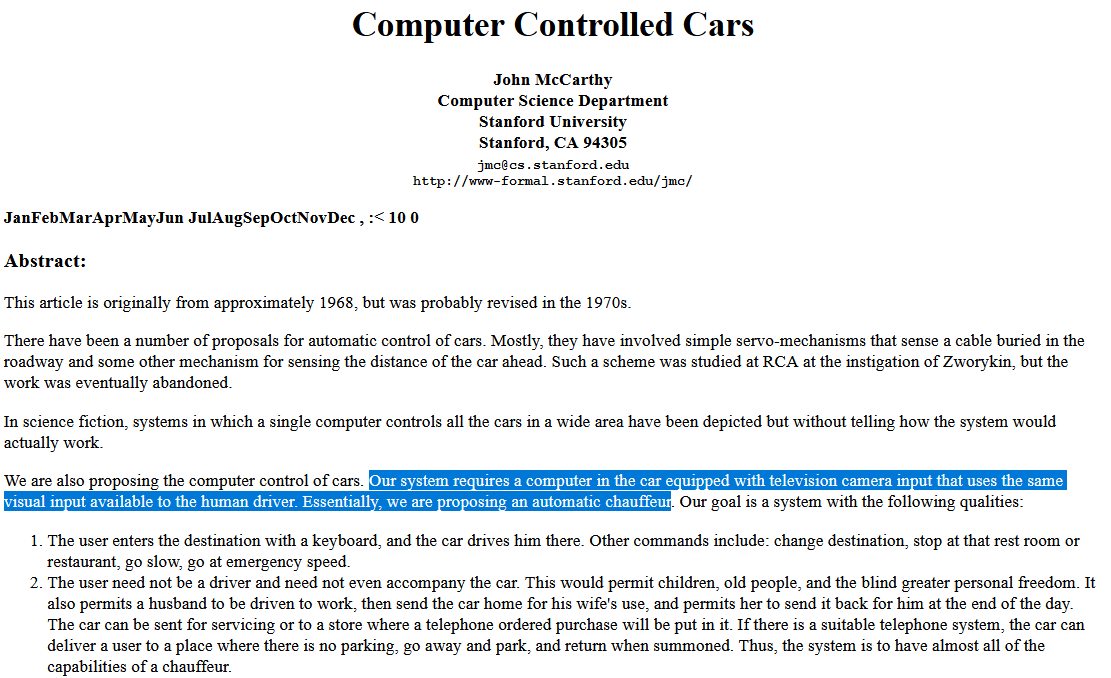
In 1977 in Japan at Tsukuba Mechanical Engineering Lab a vehicle could achieve autonomously speeds up to 30 km/h by tracking white street markers on the road. It was as far as we know the first vision-based "autonomous vehicle", but very few infomation can be found on this project. Some illustrations are available on the web, but they're so different I'm not sure they're legit.
In 1986 Ernst Dickmanns and his team developped a Mercedes van called VaMoRs. It was capable of self-driving at the top speed of the vehicle, arount 60 mph. The van was fitted with a master computer and a parallel-processing system consisting of 10 Intel 8086 CPU which processed 32x32 pixel areas determined to be interesting. In 1987 the van was capable of collision avoidance and obstacle detection. A vehicle that could "see" and drive itself at a normal speed ... 35 years ago ! It explains why Dickmanns is considered as a pioneer for autonomous driving. More info in this video
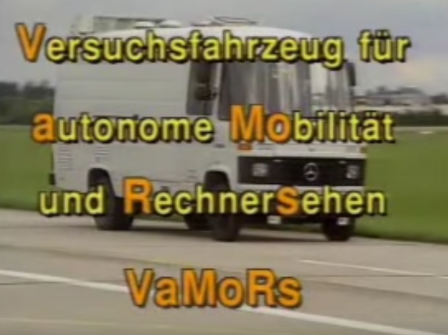
In 1987 began the european project PROMETHEUS : PROgraM for a European Traffic of Highest Efficiency and Unprecedented Safety.
Dickmanns participated in this project in collaboration with Daimler, and VaMoRs evolved towards the VaMP platform and its twin VITA-2, based on S-class Mercedes (credit [2])
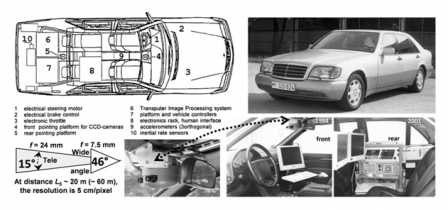
As a result in October 1994 both vehicles were the stars of the final international presentation of the project :
With a safety driver and guests on board, the twins drove more than 1000 km in normal traffic on the three-lane highway at speeds up to 130 km/h. They demonstrated lane changes left and right, autonomously passing other cars after maneuver approval by the safety driver.
One year later, the autonomous Mercedes-Benz drove more than 1,000 miles (2,000 km) from Munich to Copenhagen and back in traffic at up to 180 km/h, again planning and executing maneuvers to pass other cars with safety driver approval. However, only in a few critical situations (such as unmodeled construction areas) a safety driver took over completely.
During the same project Volkswagen has also demonstrated a platooning capability on test tracks (see this 1989 video)
Research on computer controlled vehicles had begun at Carnegie Mellon in 1984 and production of the first vehicle, Navlab 1, began in 1986. ALVINN, which stands for Autonomous Land Vehicle In a Neural Network, was used by Dean Pomerleau for his PhD thesis[3]. This was the first application of neural networks for autonomous driving :
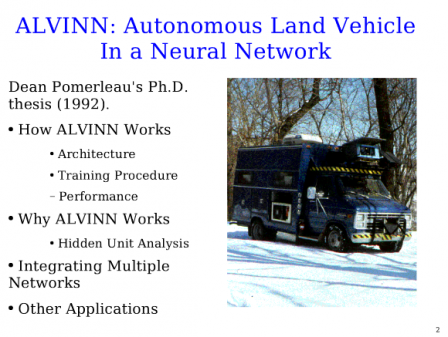
In 1995 the same team completed a "No Hands Across America tour". The vehicle (aka "Portable Navigation Platform") was a Pontiac Trans Sport, 5th generation of the Navlab family (see also wikipedia). The algorithm was called RALPH for Rapidly Adapting Lateral Position Handler.
As the pre-trip press release says, "Research scientist Dean Pomerleau and robotics doctoral student Todd Jochem won't touch the steering wheel but they will operate the throttle and brakes".
They finally managed to drive "no hands" 98% of the time.
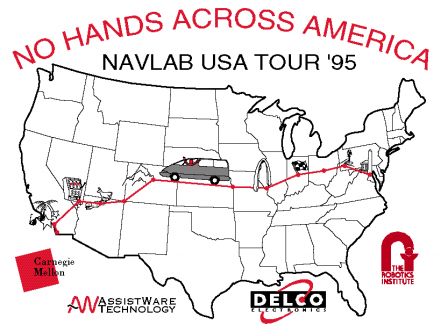
Here are a couple of recent articles worth reading about this story :
- 25 Years Ago, the First Robot Car Drove Across America’s Highways (2020)
- With self-driving tech was new, a road trip paved the way (2020)
- Driverless milestone: No Hands Across America (2017)
In 1986 UC Berkeley had started a R&D program called PATH : Partners for Advanced Transportation Technology.
They first worked on longitudinal control, then participated in the National Automated Highway System Consortium which led to the demonstration of a four-vehicle platoon capability in San Diego in 1994, then in 1997 including lane changes. See this 1997 video, and this pdf
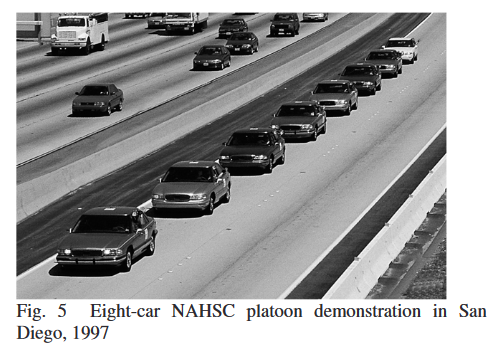
Back in Europe, after the end of the Prometheus project one of the contributing teams from the University of Parma (Italy) started a project called ARGO, and in 1998 a vehicle drove 2000 kms through Italy, 94% of the time in automatic mode, with off-the-shelf and low cost technology (a Pentium 200 MHz PC and two low-cost video-phone cameras).
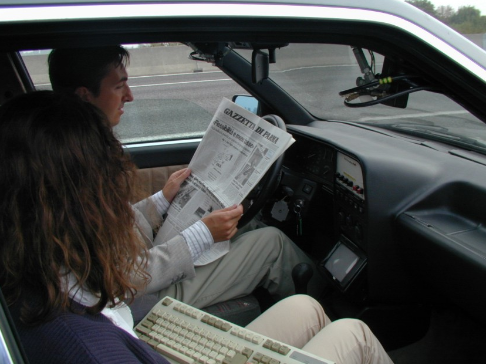
In the more recent era (post-2000) of autonomous driving, the "Grand Challenge" launched by the DARPA (R&D agency of the US department of defense) is a cornerstone. The first edition in 2004 was a complete failure : the objective was to drive 150 miles in the Mojave desert in California, but the best team covered less than 8 miles (!) in several hours.
However the progress was fast, because for the 2nd edition in 2005 five vehicles successfully completed the 132 miles course, the winner being the Stanford project called Stanley. The lateral control strategy is still known as the Stanley algorithm today, and used under this name by famous simulation softwares. The vehicle was a VW Touareg, fitted with 5 Lidars, a camera, inertial sensors and ... 6 computers in the trunk [4] :
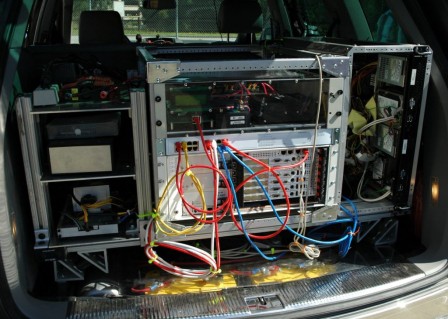
The 3rd edition took place in 2007 and became the "Urban Challenge". It was won by Carnegie Mellon University at an average 14 mph speed, Stanford finishing at the second place. The complexity was increased by the requirement to obey traffic laws, to interact with other vehicles or pedestrians, to manage intersections ...
In 2010 the italian VisLab company, founded by the guys from the ARGO project mentioned above, launched a convoy of vehicles from Italy to China for the VisLab Intercontinental Autonomous Challenge, driving almost 10 000 miles from July to October. They were small electric vans manufactured by Piaggio, fitted with lidars, stereo cameras, a panoramic vision system, a localization unit and a solar panel. They drove in pairs, the first vehicle being autonomous "most of the time", and the second following the first in 100% autonomous mode.
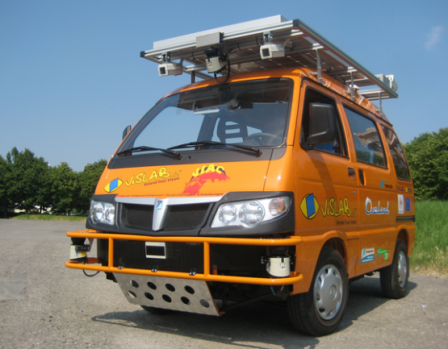
In the last decade, some people played a major role, and most of them were involved in projects mentioned above :
- Sebastian Thrun was the director of AI Stanford Lab when the team won the 2005 DARPA challenge. He was recruited by Google to drive their self-driving effort
- Anthony Levandowski participated to the DARPA challenge with a motorcycle project[5] for UC Berkeley. He met Thrun there, and was hired with him by Google in 2007. Levandowski left Google in 2016 to found Otto company, which was acquired a few months later by Uber.
- Chris Urmson was a colleague of Pomerleau at Carnegie Mellon and a major contributor of CMU team for DARPA challenges. He was later recruited by Thrun for Google, which he left in 2016 to found Aurora.
Of course all Tesla-fans would throw me rotten tomatoes if I didn't mention Elon Musk, who decided to release Autopilot in 2015. It's a bit more advanced than 1958's Chrysler Autopilot, but it's not (yet) fully autonomous :)
But this isn't "history" anymore and will be the subject of another article. More soon ...
References and additional links :
- Automated Highway History, a great 6' video from the origins of self-driving vehicles
- A Brief History of Automated Driving, a series of 3 blog posts by Jan Becker (currently CEO of Apex.AI)
- History of self-driving cars on Wikipedia
- Robot, Take the Wheel: The Road to Autonomous Cars and the Lost Art of Driving, a book by Jason Torchinsky (2019)
- The man who invented the self-driving car - in 1986 (2018)
- The VaMoRs Was the World's First Real-Deal Autonomous Car (2017)
- Meet ALVINN, the self-driving car from 1989 (2016)
- Future Past: Self-Driving Cars Have Actually Been Around for a While
- Automated Driving in Its Social, Historical and Cultural Contexts (2016)
- Where to? A History of Autonomous Vehicles (2014)
- Look Ma, No Hands! A Brief History of Self-Driving Cars (2010)
- Ernst Dickmanns publications (google scholar)
Notes
[1] credit http://imperialclub.com/Articles/58AutoPilot/index.htm
[2] By Ernst D. Dickmanns - Ernst D. Dickmanns, CC BY-SA 3.0, https://commons.wikimedia.org/w/index.php?curid=40817883
[3] source http://www.cs.cmu.edu/afs/cs.cmu.edu/academic/class/15782-f06/slides/alvinn.pdf
[4] source https://computerhistory.org/blog/where-to-a-history-of-autonomous-vehicles/
[5] youtube DARPA: Team Blue Ghostrider

